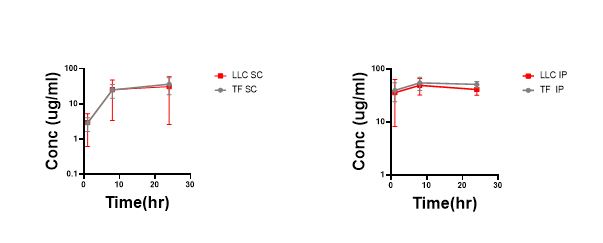Discovery and Basic Research
Category: Late Breaking Poster Abstract
(M1530-05-29) The Effect of Cancer-Associated Cachexia on the Pharmacokinetics of Extra-vascularly Administered Monoclonal Antibodies

Adeoluwa Adeluola, M.S. (he/him/his)
Graduate Student
Ohio State University
Columbus, Ohio, United States- AA
Adeoluwa Adeluola, M.S. (he/him/his)
Ohio State University
Columbus, Ohio, United States - JT
Justin Thomas
Ohio State University
Columbus, Ohio, United States - LG
Lauren Granchie
Ohio State University
Columbus, Ohio, United States - BR
Bryan Remaily
Ohio State University
Columbus, Kentucky, United States - MH
Min Hai
Ohio State University
Columbus, Ohio, United States - GY
Gregory Young
Ohio State University
Columbus, Ohio, United States - KK
Kyeongmin Kim
Ohio State University
Columbus, Ohio, United States - ZX
Zhiliang Xie
Ohio State University
Columbus, Ohio, United States - SK
Sam Kulp, Ph.D.
Ohio State University
Columbus, Ohio, United States - MP
Mitch Phelps, Ph.D.
Ohio State University
Columbus, Ohio, United States - CC
Chris Coss, Ph.D.
Ohio State University
Columbus, Ohio, United States
Presenting Author(s)
Main Author(s)
Co-Author(s)
Purpose: The function of Fc receptors is crucial for the pharmacokinetics and effectiveness of monoclonal antibody therapies. One of the Fc receptors, FcRn, plays a vital role in prolonging the half-life of monoclonal antibodies (mAb) based on IgG by recycling them and assisting their movement through biological membranes. Nevertheless, in cancer-related cachexia, there are indications that the function of FcRn is changed, resulting in the quicker elimination of IgG-based therapies in cachectic patients. Our aim was to identify possible effects of cancer-associated cachexia on the pharmacokinetics of monoclonal antibodies administered via extravascular routes. We hypothesized that the alteration in FcRn’s function in cancer-associated cachexia is not limited to mAb elimination but would also affect the extravascular absorption of therapeutic mAbs.
Methods: We conducted a pharmacokinetic study that compared the rate of absorption and bioavailability of Pembrolizumab administered via IV, IP, and SC routes in cachectic and tumor-free mice. Plasma samples were obtained from treated mice over 8 days (1-192hrs) and analyzed for pembrolizumab concentration using ELISA techniques (Fig 1).
Results: Pembrolizumab clearance was elevated in all LLC tumor-bearing (TB) mice relative to tumor free (TF) controls, irrespective of dose route. However, cachexia-mediated inductions in clearance were smaller following extravascular IP and SC doses as compared to IV pembrolizumab administration, contrary to our initial hypothesis (Fig 2). On the other hand, the absorption phases of pembrolizumab in TF and LLC mice overlapped nicely suggesting that mAb absorption via extravascular routes was not altered significantly by cachexia burden at the time of dosing (Fig 3).
Conclusion: Therefore, we conclude that FcRn’s function in the absorption of mAb therapies was not altered significantly by cachexia. It is possible that the effect of cachexia on the absorption of mAbs depends on the cachectic burden at the time of administration; however, this requires further investigation.
References: Richter, W. F., Christianson, G. J., Frances, N., Grimm, H. P., Proetzel, G., & Roopenian, D. C. (2018). Hematopoietic cells as site of first-pass catabolism after subcutaneous dosing and contributors to systemic clearance of a monoclonal antibody in mice. mAbs, 10(5), 803–813.
 Figure 1: Flowchart of Study Design
Figure 1: Flowchart of Study Design Figure 2: Concentration-time plots of pembrolizumab in tumor free and tumor bearing mice: Pembro administered IV (A), IP (B) and SC (C) routes. As expected, the results show a steeper slope in the elimination phase when comparing the tumor free and tumor bearing groups. Data are shown as mean ± SD.
Figure 2: Concentration-time plots of pembrolizumab in tumor free and tumor bearing mice: Pembro administered IV (A), IP (B) and SC (C) routes. As expected, the results show a steeper slope in the elimination phase when comparing the tumor free and tumor bearing groups. Data are shown as mean ± SD. Figure 3: Concentration-Time plots showing the absorption phase of Pembrolizumab grouped by tumor status. SC (A) and IP-dosed mice (B) show no difference in the absorption phase between the tumor free and tumor bearing groups. Based on reports by Richter et al (2018), this suggests that FcRn’s function is intact at least on the hematopoietic cells in the tumor bearing model. Data are shown as mean ± SD.
Figure 3: Concentration-Time plots showing the absorption phase of Pembrolizumab grouped by tumor status. SC (A) and IP-dosed mice (B) show no difference in the absorption phase between the tumor free and tumor bearing groups. Based on reports by Richter et al (2018), this suggests that FcRn’s function is intact at least on the hematopoietic cells in the tumor bearing model. Data are shown as mean ± SD.